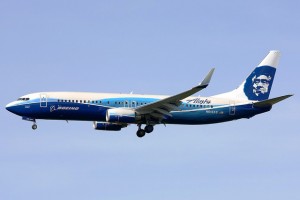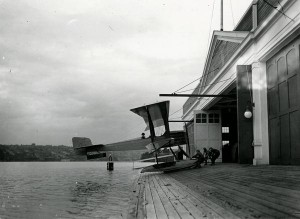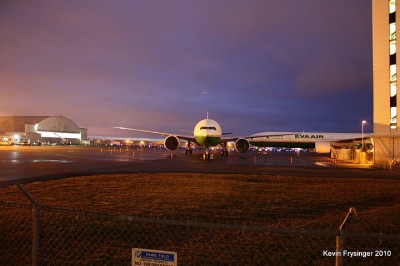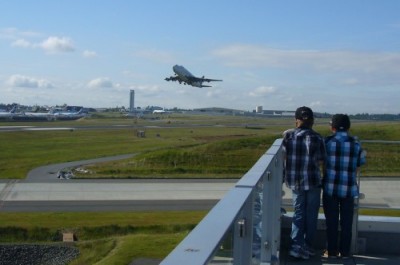
Alaska Airlines 737-800 with special Boeing livery (N512AS)
Alaska Airlines, Boeing, Portland International Airport, Seattle-Tacoma International Airport, Spokane International Airport and Washington State University are working together to promote aviation biofuel development in the Pacific Northwest. The regional assessment is called the Sustainable Aviation Fuels Northwest (SAFN).
The group hopes to examine all phases of developing an aviation biofuel industry and the funding is being split between the involved parties. SAFN will be looking at local biomass sources that can be found in the Pacific Northwest.
“By transitioning to a more fuel-efficient fleet and adopting technology to follow more direct flight paths, Alaska Airlines has made significant strides in minimizing the environmental impact of our flying in the communities we serve,” said Alaska Air Group Chairman and CEO Bill Ayer. “Through this initiative, we are joining other key stakeholders in our region to explore the development of alternatives to jet fuel that could further reduce our carbon footprint.”
The project is starting this month and is expected to take about six months. Air travel currently generates approximately 2 percent of man-made carbon emissions, and the industry has set aggressive goals to lower its carbon footprint, which includes the use of aviation biofuel when it becomes available.
This is only one of several regional biofuel projects that Boeing is currently working with. Curious to find out what Boeing hopes to achieve in this project, I spoke with Terrance Scott, who is with Boeing Environmental Communications. He explained there are four ways to help airlines curb their carbon emissions. The first is product development, where Boeing creates new, more fuel efficient aircraft, like the Boeing 787 and the Boeing 747-8. The second is to retrofit currently flying aircraft with performance packages, winglets and other items. Third is to change the way airlines fly and operate aircraft in order to be more efficient. The last way is the type of fuel used to power the aircraft.
Boeing has helped or will be helping to set up similar regional groups in the Middle East, China, Australia and Mexico. The hope is to create a regional portfolio of fuel sources to create aviation biofuel. Scott told me that Boeing wants to motivate people to find answers, but is not looking to get into the biofuels business themselves. “Boeing doesn’t want to get into the fuel business, but we want to serve as a catalyst.” Their plan is to bring people together, to start talking and working on creating sources for biofuel.
The use of biofuels have already been successfully tested. Boeing has worked with Air New Zealand and Continental to show airlines can successfully use biofuels. Now that biofuel has been proven to be a good alternative to legacy jet fuel, the shift is being made to find a sustainable, economically feasible fuel source. They want to make sure that a fuel source won’t compete with any food source (ie corn and E85).
Most likely any biofuel will cost more than jetfuel today. Would passengers be willing to pay a little bit more to fly green? I think there are some that would, but I am not sure if there would be enough.
http://safug.org/
Image: Axel J

The first Boeing plane at their first assembly building, on Seattle's Lake Union. Picture from Boeing.
94 years ago today, the Pacific Aero Products Co was founded by William E Boeing in Seattle, WA and it has been an amazing ride since! Some key moments in their history:
1917: The company was renamed to the Boeing Airplane Company.
1927: Boeing started their own airline called Boeing Air Transport.
1933: Due to new regulations, Boeing was split into three companies: United Airlines, United Aircraft Corporation and the Boeing Airplane Company. This is the year that William Boeing also left Boeing.
1938: The first flight of the Boeing 314 Clipper.
1944: Due to the war over 350 aircraft were being built each month.
1957: The Boeing 707 has its first flight.
1960: Boeing purchased Vertol Aircraft Company which got them into the business of helicopters.
1963: The amazing Boeing 727 takes off for the first time.
1967: Just four years after the 727 has its first flight, the Boeing 737 takes to the sky.
1969: The first wide-bodied airliner, the Boeing 747, has its first flight and changes airline transportation forever.
1971: Funding for the Boeing 2707, the supersonic airliner, was cut.
1981: The first wide-bodied, twinjet airliner, the Boeing 767 has its first flight.
1982: The Boeing 757 has its first flight.
1994: The Boeing 777 successfully has its first flight.
1996: Boeing merges with McDonnell Douglas.
1998: The Boeing 717, which started life as the MD-95, has its first flight.
2001: Boeing moved its corporate headquarters from Seattle to Chicago.
2009: The much anticipated Boeing 787 Dreamliner has its first flight.
To read more about Boeing’s history, be sure to check out their huge history section on their website.

This is back in January when there were just two Eva Air Boeing 777-300ER's sitting at Paine Field. Photo by Kevin Frysinger
I am up at Paine Field quite a bit. This is where many of Boeing’s aircraft are made: the 777, 787, 747 and 767. For months I have seen two brand new Eva Air Boeing 777-300ER’s sitting by the control tower. The last time I went by, there were three. Why would Eva Air let three brand new planes worth about $800,000,000.00 just sit and not make revenue? Well, it turns out they have no seats and the problem extends beyond Eva Air.
The seat manufacturer Koito, based in Japan, falsified safety test results and in September of 2009, the European Aviation Safety Agency (EASA) withdrew approval for the seats. EASA claimed that 16g, 9g and flammability test data were affected and the EASA stopped Airbus from installing any additional seats.
Flight Global and ATI reports that these falsified tests affected as many as 150,000 seats on 1,000 aircraft. How can this happen? Multiple sources have confirmed to Flight Global and ATI that Koito falsely indicated that some seats had been cleared by the Japan Civil Aviation Bureau (JCAB) by illegally forging the JCAB’s stamp of approval.
Many airlines have had to deal with the delays of aircraft delivery due to Koito’s issues and yet there are even more airlines that already have the seats installed. Earlier, Boeing sent people to Japan to help Koito solve its quality issues. However, it seems that their help wasn’t enough and Boeing told me they will no longer offer Koito seats to customers.
I also asked Boeing if the seats already on airlines are safe and Bev Holland, Boeing Manufacturing & Quality Communications Specialist, explained, “Boeing has a comprehensive system in place to make sure seats conform to FAA specifications before being installed. While we are working to help those customers who have previously ordered Koito seats to make sure the seats are correctly installed and certified, Koito seats are no longer an option for new orders. ”
When I asked Boeing about the Eva Air Boeing 777’s, Holland stated, “we do not discuss our customers’ airplanes,” but she did confirm that, “seats are buyer-furnished equipment.”
I can respect Boeing not talking on behalf of an airline, so I went to talk to Eva Air. I was looking to see if Eva would confirm why the Boeing 777’s are not being used, what their game plans for the aircraft are and if they are paying parking fees to Paine Field (which is actually owned by Snohomish County). I heard back from Katherine Ko, Jr Vice President of Public Relations for Eva and she stated, “Our priorities are safety and quality service, and those aircraft are there for aircraft update.” I was hoping for a bit more information, but I can understand the airline not wanting to say too much publicly right now, especially if any legal action is taken in the future.
Since Boeing and Airbus are no longer providing the seats, are the ones currently flying safe? I am told they are safe and it has not proven that they are not, it has just been proven that Koito falsified records. Currently there is an advisory board made up of the JCAB, Airbus, Boeing, All Nippon Airways, Japan Airlines, and Koito determining if the seats are safe. The board is requesting airlines who currently fly with Koito seats to donate a few, so testing can be done to see if they are safe. I am not sure how well that will go. I know airlines care about the safety of their passengers but do they really want to donate seats that might help to determine if they are defective and need to be replaced?
I also wondered why the Federal Aviation Administration (FAA) wasn’t more involved in this matter since there are quite a few Koito seats flying in the United States. Would the FAA issue an Airworthiness Directive (AD) requiring all US airlines to replace the seats? I contacted them to find out and got some surprising answers.
I communicated with Alison Duquette, who is with the FAA Office of Communications, about the certification of the seats and she told me, “The Koito seats were approved through the US/Japan bilateral agreements. The JCAB reviews and accepts all data and the FAA then accepts their test data via our bilateral agreement.” This means the FAA just rubber-stamps JCAB’s approval, which was falsely rubber-stamped by Koito. Pushing to see if the FAA might possibly issue an AD she explained, “Japan is the certifying authority so they would be the government to issue a directive and then the FAA could follow.”
I asked the FAA if any new rules have been put into place after this incident and Duquette told me, “The JCAB has a process in place to make sure to correct any problems.” When I asked what the FAA thought about the forged approval by Koito, in essence by-passing the JCAB approval, Duquette referred me to the JCAB. At this point, it seems the FAA is taking a very hands-off approach.
So, what now? I am not exactly sure. Do I want the industry to have to spend millions during a time when they really cannot afford it? Of course not. However, I don’t want it to take an accident and people needlessly getting injured or die because they were sitting in faulty seats. I am sure this will be an on-going story. At the time of publishing this blog, I have not been able to get in contact with the JCAB or Koito. I will continue to work with Mary Kirby with Flight International (she also writes the RunwayGirl blog) on finding more answers.
No matter what happens, I really hope that those Eva Air Boeing 777’s can get into the sky soon; it is a shame seeing those beautiful birds stuck on the ground.
Image by @TxAgFlyer

Harry and his brother Charlie watch as a Boeing Dreamlifter takes off from Paine Field
A while back I wrote a blog talking about how Boeing is making a real effort to connect more with the general public. In that post I talked about how eight year old Harry Winsor submitted a drawing of a new Boeing plane. Unfortunately, Boeing sent a canned letter saying they accept no outside ideas and will be shredding his photo.
This didn’t sit well for Harry or his father, John. Bloggers and some other media picked up on the story and Boeing sprung into action admitting this is not how the new Boeing wants to do things.
To celebrate the spirit of flight, The Future of Flight, located in Everett, WA set up a drawing event where people can submit their crazy airplane designs (mine was an awesome cube-plane).
For Father’s Day, John, Harry, his mother and brother made their way to Seattle from Colorado to see the art he had inspired and get a tour from the Future of Flight and Boeing.
Since I was out of town, I was not able to join in the festivities. However Aubrey Cohen with the Seattle PI and Harriet Baskas were there to cover his adventures.
Even though Harry and his family got VIP treatment and a special tour of the Boeing facility, the pinnacle was meeting Boeing aircraft design engineer, Cam Carnegie. Carnegie had written to Harry after he got his form letter and now really wanted to help him dream. “I just kind of wanted to show him that progression from dreamer to being an engineer,” Carnegie told Aubry with the Seattle PI.
Todd Blecher, Media Communications Director for Boeing, flew out from Chicago to meet the Windsors (I hope he got to fly on a Boeing). He spoke about the fumble and said that for legal reasons Boeing has to send out the form letter to people submitting ideas, but says they have a new and special letter for kids.
“If it’s a letter from an adult pitching an idea, we know exactly what to do. When it’s a child, there’s a difference,” he said. “They uncovered a flaw in our process that needed to be fixed.”
Blecher told Harriet Baskas that they are still working on the letter. The first version was too dry and formal and the second sounded too much like a recruitment letter. Blecher said his boss took the third version home to his five kids for some real-world feedback.
As Blecher told me previously, Boeing’s transition won’t happen over night, but they are making a real effort. There is still talk about a Facebook page and even a Tweetup for Boeing fans in the Seattle area. I hope to see those outreach efforts and others soon!
* Photos from the Seattle PI
* A write up from Harriet Baskas
Double good news from Boeing on the Boeing 737. Boeing announced they will sign a 40 year contract with Renton Municipal Airport to keep flying new Boeing 737’s from their plant next to the airport. Boeing states they have no plan to move Boeing 737 production from Renton, WA up north to Everett, WA (where the Boeing 767,777, 747 and 787 are made) or to another location in the country.
Boeing also announced their plan to ramp up production for the 737 from 31.5 units per month to 34. Boeing expects orders for the 737 to increase with the global economy improving.
connect | web | twitter | facebook |



